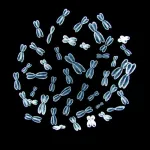(Press-News.org) KYOTO – An international team of researchers has taken an important step toward understanding how gene expression is controlled across the human genome. A new study has comprehensively analyzed “cis-regulatory elements” (CREs), which are the DNA sequences that regulate gene transcription. This work sheds light on how these elements contribute to cell-specific gene expression and how mutations within them may influence health and disease.
CREs, including enhancers and promoters, are essential for controlling when and where genes are turned on or off. While their importance is well established, studying their activity at a large scale has been a challenge. “The human genome contains a myriad of CREs, and mutations in these regions are thought to play a major role in human diseases and evolution,” explained Dr. Fumitaka Inoue, one of the co-first authors of the study. “However, it has been very difficult to comprehensively quantify their activity across the genome.”
To address this, the team used a cutting-edge technology called the lentivirus-based massively parallel reporter assay (lentiMPRA), which the authors had previously developed. This approach enables simultaneous analysis of thousands of CREs by tagging them with unique DNA barcodes that track their activity. Applying lentiMPRA, the researchers examined as many as 680,000 candidate CREs in three widely used cell types: hepatocytes (cells from the liver), lymphocytes (a type of white blood cell), and induced pluripotent stem cells (a type of artificial stem cell made from a normal body cell).
The study revealed several key insights. Across the three cell types, approximately 41.7% of the analyzed CREs exhibited activity. Promoters, which start gene transcription, showed a dependence on sequence orientation but were less specific to cell types. Enhancers, which boost gene transcription, were active regardless of their orientation and exhibited cell-type specificity. These findings highlight fundamental differences in how these two types of CREs function.
In the study, several machine learning models were developed to predict the regulatory activity of CREs based on large-scale experimental data. MPRALegNet, a model trained on the vast lentiMPRA dataset, was found to be the most accurate and efficient in predicting the regulatory activity of any DNA sequence. Its predictions align closely with experimental results, performing as well as experimental replicates in some cases. The model also demonstrated its ability to identify important transcription factor binding motifs—that is, short DNA sequences that determine CRE activity—thus providing insights into how specific factors drive cell-type-specific gene expression. For example, the study identified HNF4 and GATA motifs as crucial for activity in hepatocytes and lymphocytes, respectively.
By enabling the precise identification and quantification of enhancer activity, the study opens avenues for exploring the molecular mechanisms of human diseases. Future research will focus on applying this approach to study genetic polymorphisms, the variations in DNA sequence that contribute to individual differences and disease susceptibility.
“Recently, the nearly complete human genome has been sequenced, but much of its functional regions remain unknown. Our findings link DNA sequence information with its functional roles. We hope that these results will contribute to a deeper understanding of biological phenomena, including human diseases and evolution,” said Dr. Inoue.
This study also contributes a publicly accessible database of CRE activity to the ENCODE portal, providing a valuable resource for researchers worldwide. By integrating large-scale experimental data with machine learning, the work sets a foundation for future discoveries in genomics and personalized medicine. In addition, the use of tools like lentiMPRA and MPRALegNet will help to better equip researchers to unravel the complexities of gene regulation and to explore the vast, uncharted territories of the human genome.
Writing: ThinkSCIENCE, Inc. (Tokyo, Japan)
###
About Institute for the Advanced Study of Human Biology (ASHBi), Kyoto University
What key biological traits make us ‘human’, and how can knowing these lead us to better cures for disease? ASHBi investigates the core concepts of human biology with a particular focus on genome regulation and disease modeling, creating a foundation of knowledge for developing innovative and unique human-centric therapies.
About the World Premier International Research Center Initiative (WPI)
The WPI program was launched in 2007 by Japan's Ministry of Education, Culture, Sports, Science and Technology (MEXT) to foster globally visible research centers boasting the highest standards and outstanding research environments. Numbering more than a dozen and operating at institutions throughout the country, these centers are given a high degree of autonomy, allowing them to engage in innovative modes of management and research. The program is administered by the Japan Society for the Promotion of Science (JSPS).
END
Mapping gene regulation
Insights into human genome function
2025-01-16
ELSE PRESS RELEASES FROM THIS DATE:
Exposure to air pollution before pregnancy linked to higher child body mass index, study finds
2025-01-16
In a study of more than 5,000 mothers and their children, exposure to air pollution during the three months before pregnancy predicted higher child body mass index (BMI) and related obesity risk factors up to two years of age. Findings from the study, which was supported by the National Institute of Environmental Health Sciences, were published in the journal Environmental Research.
Past research has linked air pollution exposure during pregnancy to a broad range of health problems in children, including respiratory ...
Neural partially linear additive model
2025-01-16
Interpretability has drawn increasing attention in machine learning. Partially linear additive models provide an attractive middle ground between the simplicity of generalized linear model and the flexibility of generalized additive model, and are important models for addressing the two interpretability problems of feature selection and structure discovery. The existing partially linear additive models still have various imperfect performances in terms of fitting ability.
To solve the problems, a research team lad by Han LI published their new research on 15 December 2024 in Frontiers of Computer Science co-published by Higher Education Press and Springer Nature.
The ...
Dung data: manure can help to improve global maps of herbivore distribution
2025-01-16
Researchers have used dung records to create high-resolution maps of herbivore distribution around the world. Their new study, recently published in Nature Food, reveals a strong positive relationship between dung presence and grazing pressure, meaning the amount of dung found in a particular location could help us understand approximately how many herbivores live there.
Many people consider dung simply as the manure left behind by horses and cows at country shows, or something to be avoided when you visit the cousins’ farm. But dung is actually an important resource for millions of people worldwide.
Dung ...
Concerns over maternity provision for pregnant women in UK prisons
2025-01-16
Senior midwives and researchers with experience in criminal and social justice are among those calling for improved maternity provision for pregnant women in UK prisons.
In an article published by The BMJ today, Laura Abbott and colleagues highlight gaps in clinical care for pregnant women and say the systemic problems need tackling urgently to protect the health of pregnant women, new mothers, and babies while in criminal justice settings.
Figures from April 2023 to March 2024 show that 229 pregnant women ...
UK needs a national strategy to tackle harms of alcohol, argue experts
2025-01-16
The UK needs an overarching national strategy to tackle alcohol related harms, argue experts in The BMJ today, as deaths from alcohol in England reach their highest level on record.
Julia Sinclair at the University of Southampton and colleagues warn that successive government cuts have led to reduced provision and quality of alcohol treatment, and say sustained funding is needed for screening and care, while industry must also shoulder some of the costs.
Alcohol is widely available and drunk by around 80% of adults in the UK and is now well established as ...
Aerobic exercise: a powerful ally in the fight against Alzheimer’s
2025-01-16
Regular aerobic exercise could significantly reduce disease markers associated with Alzheimer’s, new research led by scientists at the University of Bristol (UK) and the Federal University of São Paulo (Brazil) has found. The findings provide new hope in the battle against this devastating disorder.
Published in the journal Brain Research, the study highlights how physical activity not only protects healthy brain cells but also restores balance in the aging brain.
The research focused on ...
Cambridge leads first phase of governmental project to understand impact of smartphones and social media on young people
2025-01-16
Cambridge researchers are leading the first phase of a new research project that will lay the groundwork for future studies into the impact on children of smartphone and social media use.
The work has been commissioned by the UK government’s Department for Science, Innovation and Technology after a review by the UK Chief Medical Officer in 2019 found the evidence base around the links to children’s mental health were insufficient to provide strong conclusions suitable to inform policy.
The project – led by a team at the University of Cambridge, in collaboration with researchers at several leading UK universities ...
AASM Foundation partners with Howard University Medical Alumni Association to provide scholarships
2025-01-15
DARIEN, IL — The American Academy of Sleep Medicine Foundation is proud to announce a partnership with the Howard University Medical Alumni Association to support medical students at Howard University. Through the HUMAA scholarship program, the AASM Foundation is sponsoring five scholarships, each valued at $3,000.
“By supporting medical students at Howard University, we’re empowering the next generation of medical professionals who will shape the future of health care,” said Dr. R. Nisha Aurora, president of the AASM Foundation. “We’re also hoping to inspire students to consider careers ...
Protective actions need regulatory support to fully defend homeowners and coastal communities, study finds
2025-01-15
As climate change drives increasingly severe hurricanes, U.S. coastal communities are bearing the brunt of mounting losses. With regulations failing to curb the damage, homeowners have become the front line of defense — but their efforts often fall short, a recent study reveals.
Led by Tracy Kijewski-Correa, professor of engineering and global affairs at the Keough School of Global Affairs at the University of Notre Dame, the study, published in the International Journal of Disaster Risk Reduction, explored how homeowners respond in the aftermath of hurricanes when reconstruction becomes ...
On-chip light control of semiconductor optoelectronic devices using integrated metasurfaces
2025-01-15
A new publication from Opto-Electronic Advances; DOI 10.29026/oea.2025.240159, discusses on-chip light control of semiconductor optoelectronic devices using integrated metasurfaces.
Since the initial demonstration of the first semiconductor laser in the early 1960s, semiconductor optoelectronic devices have achieved unparalleled commercial success and permeated every facet of human lives from communication, lighting, and entertainment to medicine. Furthermore, in response to the emergence of novel applications, such as the consumer electronics, AR/VR ...
LAST 30 PRESS RELEASES:
Post-stroke injection protects the brain in preclinical study
Cardiovascular risk score predicts multiple eye diseases
Health: estimated one in ten British adults used or interested in GLP-1 medications for weight loss
Exercise to treat depression yields similar results to therapy
Whooping cough vaccination for pregnant women strengthens babies’ immune system
Dramatic decline in new cases of orphanhood in Uganda driven by HIV treatment and prevention programs
Stopping weight loss drugs linked to weight regain and reversal of heart health markers
Higher intake of food preservatives linked to increased cancer risk
Mass General Brigham–developed cholera vaccine completes phase 1 trial
First experimental validation of a “150-year-old chemical common sense” direct visualization of the molecular structural changes in the ultrafast anthracene [4+4] photocycloaddition reaction
Lack of support for people on weight loss drugs leaves them vulnerable to nutritional deficiencies, say experts
Dogs’ dinners can have greater climate impact than owners’
Are you ready to swap salmon for sprats and sardines?
1.6 million UK adults used weight loss drugs in past year
American College of Cardiology comments on new dietary guidelines for Americans
American Society of Gene & Cell Therapy and Orphan Therapeutics Accelerator partner to advance and commercialize promising rare disease treatments
One in 14 patients having day case surgery have new or worse chronic pain 3 months after their operation
New study highlights link between eviction rates and gun violence
Heatwaves heat up soil but not toxin levels in rice, study finds
Digital modeling reveals where construction carbon emissions really come from
Turning farm waste into water filters
New study shows how the spleen helps the immune system accept a transplant
New Mayo Clinic study advances personalized prostate cancer education with an EHR-integrated AI agent
Researchers identify novel therapeutic target to improve recovery after nerve injury
Microbes in breast milk help populate infant gut microbiomes
Reprogramming immunity to rewrite the story of Type 1 diabetes
New tool narrows the search for ideal material structures
Artificial saliva containing sugarcane protein helps protect the teeth of patients with head and neck cancer
Understanding the role of linear ubiquitination in T-tubule biogenesis
Researchers identify urban atmosphere as primary reservoir of microplastics
[Press-News.org] Mapping gene regulationInsights into human genome function



